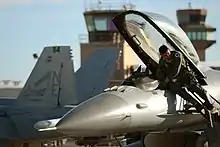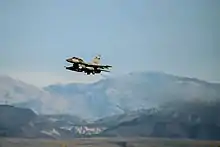| Naval Air Station Fallon | |||||||||||
|---|---|---|---|---|---|---|---|---|---|---|---|
Van Voorhis Field | |||||||||||
| Near Fallon, Nevada in the United States | |||||||||||
 A US Navy F-16A Fighting Falcon of the Naval Aviation Warfighting Development Center based at NAS Fallon | |||||||||||
 | |||||||||||
 NAS Fallon Location in the United States | |||||||||||
| Coordinates | 39°25′30″N 118°42′10″W / 39.42500°N 118.70278°W | ||||||||||
| Type | Naval air station | ||||||||||
| Site information | |||||||||||
| Owner | Department of Defense | ||||||||||
| Operator | US Navy | ||||||||||
| Controlled by | Navy Region Southwest | ||||||||||
| Condition | Operational | ||||||||||
| Website | Official website | ||||||||||
| Site history | |||||||||||
| Built | 1942 | ||||||||||
| In use | 1942 – present | ||||||||||
| Garrison information | |||||||||||
| Current commander | Captain Evan L. Morrison | ||||||||||
| Garrison | Naval Aviation Warfighting Development Center | ||||||||||
| Airfield information | |||||||||||
| Identifiers | IATA: NFL, ICAO: KNFL, FAA LID: NFL, WMO: 692364 | ||||||||||
| Elevation | 1,199.3 metres (3,935 ft) AMSL | ||||||||||
| |||||||||||
| Source: Federal Aviation Administration[1] | |||||||||||
Naval Air Station Fallon or NAS Fallon (IATA: NFL, ICAO: KNFL, FAA LID: NFL) is the United States Navy's premier air-to-air and air-to-ground training facility. It is located southeast of the city of Fallon, east of Reno in western Nevada. Since 1996, it has been home to the U.S. Navy-Fighter Weapons School (TOPGUN) taking over from the former NAS Miramar, California, and the surrounding area contains 240,000 acres (97,000 ha) of bombing and electronic warfare ranges. It is also home to the Naval Aviation Warfighting Development Center (NAWDC), which includes TOPGUN, the Carrier Airborne Early Warning Weapons School (CAEWWS) and the Navy Rotary Wing Weapons School. Navy SEAL Combat Search and Rescue (CSAR) training also takes place there.
The airfield is named Van Voorhis Field in honor of Commander Bruce Van Voorhis (1908–1943) who was awarded a posthumous Medal of Honor.
History
The airfield at NAS Fallon was originally built in 1942 as part of a defensive network to repel a feared Japanese invasion of the west coast. It was soon taken over by the Navy for training use and has been used as such ever since with the exception of the period of 1946 to 1951, during which it was used by the Bureau of Indian Affairs. During the years prior to 1972, the base was known as Naval Auxiliary Air Station and was heavily used during the Vietnam War by various squadrons that rotated through the base before deploying to carriers headed for Vietnam. During these same years prior to 1972, many ground troops were temporarily assigned to NAAS Fallon for their hot weather training (during the summer months) and cold weather training (during the winter months). On 1 January 1972, the Navy recognized NAS Fallon's importance to naval aviation by upgrading the base from auxiliary air station status to a major aviation command as a full-fledged naval air station. While NAS Fallon provides training for visiting carrier air wings, Strike Fighter Squadron 127 (VFA-127), the "Desert Bogeys", was the air station's only permanently based squadron from October 1987 until it was disestablished on 23 March 1996.

The Navy relocated its Navy Fighter Weapons School, or TOPGUN, from NAS Miramar to NAS Fallon in 1996, following the transfer of NAS Miramar to the Marine Corps and its redesignation as MCAS Miramar. This move resulted in the construction of a new ramp, hangars and academic buildings. The new command, the Naval Strike and Air Warfare Center (NSAWC), was established on 11 July 1996 and was a unification of TOPGUN, Strike University (Strike U), the Naval Strike Warfare Center, and TOPDOME, the Carrier Airborne Early Warning Weapons School. In addition to transferring the NSAWC squadron, a Navy Reserve adversary squadron, Fighter Squadron Composite THIRTEEN (VFC-13), the "Saints," was also permanently relocated from its former base at NAS Miramar to NAS Fallon. As a result, VFC-13 replaced the disestablished VFA-127 in the fighter adversary role.
Associated bombing ranges checker the surrounding Lahontan Valley and Dixie Valley, which is the next valley to the east. Dixie Valley also contains a simulated air defense network, including approximately 20 operational radar installations. Many demilitarized armored vehicles, including some exotics, have been scattered throughout the area, presumably for ambiance. Most of this area is publicly accessible, with the exception of areas immediately surrounding the radar installations. The entire training area surrounding NAS Fallon is known as the Fallon Range Training Complex (FRTC).[2][3]
USAF Radar Station
Between 1956 and 1975, the United States Air Force Air Defense Command (ADC) operated a General Surveillance Radar station at NAS Fallon. The Air Force area was named Fallon Air Force Station[4] (AFS) and designated ADC site SM-156 (later NORAD site Z-156). The 858th Aircraft Control and Warning Squadron moved to Fallon AFS from Hamilton Air Force Base (AFB), California[4] in the south central section of NAS Fallon in 1956. It initially activated AN/MPS-7 search and AN/MPS-14 height-finder radar sets, and initially the station functioned as a Ground Control Intercept (GCI) and warning station. As a GCI station, the squadron's role was to guide interceptor aircraft toward unidentified intruders picked up on the unit's radar scopes. An AN/FPS-3 search set briefly saw service in 1959.

During 1962 Fallon AFS joined the Semi Automatic Ground Environment (SAGE) system, initially feeding data to DC-16 at Stead AFB, Nevada. After joining, the squadron was redesignated as the 858th Radar Squadron (SAGE) on 1 December 1962.[4] The radar squadron provided information 24/7 the SAGE Direction Center where it was analyzed to determine range, direction altitude speed and whether or not aircraft were friendly or hostile. Also in this time frame, the radar site was relocated from the original location in the south central part of the Naval Air Station grounds to the far southwest corner. At the new SAGE radar site, the squadron used an AN/FPS-35 search radar that replaced the AN/MPS-7 set in 1963. In 1964 an AN/FPS-6 height-finder radar was added.
In addition to the main facility at NAS Fallon, the squadron also operated a remote AN/FPS-14 Gap Filler site:
- Gabbs, NV (SM-156A): 38°46′28″N 118°01′17″W / 38.77444°N 118.02139°W
Around 1965, Fallon became an FAA/ADC joint-use facility. The AN/MPS-14 radar was retired in 1969. In the early 1970s, the AN/FPS-35 was replaced with an AN/FPS-66A.
Over the years, the equipment at the station was upgraded or modified to improve the efficiency and accuracy of the information gathered by the radars. The 858th Radar Sq was inactivated and replaced by the 858th Air Defense Group in March 1970.[5] The upgrade to group status was done because of Fallon AFS' status as a Backup Interceptor Control (BUIC) master control center site. BUIC sites were alternate control sites in the event that SAGE Direction Centers became disabled and unable to control interceptor aircraft.[6] The group was inactivated and replaced by the 858th Radar Squadron.[4][5] as defenses against manned bombers were reduced only to be inactivated in June 1975.[4] The group was disbanded in 1984.[7] The FAA retained the AN/FPS-66A search radar, still in-use today and is networked into the Joint Surveillance System (JSS); the radar tower still is painted with red-and-white checkerboard.
Museum
The navy maintains the Naval Air Station Fallon Air Park museum on the base.[8]
Search and rescue team
Since 1972 the base has had its own search and rescue team. Originally named Desert Angels and later renamed Longhorns, the team's mission is to provide SAR support for visiting Carrier Air Groups and other NAS Fallon tenant commands. The Longhorns flew the Bell UH-1N from 1972 to 2009 and the Sikorsky SH-60F from 2009 to 2011. The team currently flies the Sikorsky MH-60S.[9] The Longhorns frequently support civilian search, rescue and medical evacuation efforts in conjunction with local law enforcement, medical and search and rescue agencies.
Gallery
 A 157th Fighter Squadron F-16 Fighting Falcon prepares for a mission, November 2014.
A 157th Fighter Squadron F-16 Fighting Falcon prepares for a mission, November 2014. A 157th Fighter Squadron F-16 Fighting Falcon takes off, November 2014.
A 157th Fighter Squadron F-16 Fighting Falcon takes off, November 2014. A U.S. Navy Sikorsky MH-60S Sea Hawk helicopter (BuNo 165769) attached to the "Longhorns"
A U.S. Navy Sikorsky MH-60S Sea Hawk helicopter (BuNo 165769) attached to the "Longhorns"
See also
References
Notes
- ↑ FAA Airport Form 5010 for NFL PDF
- ↑ "Fallon Range Training Complex". www.cnic.navy.mil.
- ↑ "Fallon Range Training Complex (FRTC)". www.globalsecurity.org.
- 1 2 3 4 5 Cornett & Johnson, p. 171
- 1 2 Cornett & Johnson. p.86
- ↑ Winkler & Webster, p. 41
- ↑ Department of the Air Force/MPM Letter 575q, 27 Sep 1984, Subject: Disbandment of Units
- ↑ "Naval Air Station Fallon Air Park". Retrieved November 28, 2019.
- ↑ AirForces Monthly. Stamford, Lincolnshire, England: Key Publishing Ltd. November 2021. p. 95.
Bibliography
 This article incorporates public domain material from the Air Force Historical Research Agency
This article incorporates public domain material from the Air Force Historical Research Agency- Cornett, Lloyd H; Johnson, Mildred W (1980). A Handbook of Aerospace Defense Organization, 1946–1980 (PDF). Peterson AFB, CO: Office of History, Aerospace Defense Center.
- Winkler, David F.; Webster, Julie L (1997). Searching the skies: The legacy of the United States Cold War Defense Radar Program. Champaign, IL: US Army Construction Engineering Research Laboratories. LCCN 97020912.
Further reading
- Leonard, Barry (2009). History of Strategic Air and Ballistic Missile Defense (PDF). Vol. II, 1955–1972. Fort McNair, DC: Center for Military History. ISBN 978-1437921311. (USAF Radar site)
- STRIKE: U.S. Naval Strike Warfare Center (Presidio Press, ISBN 0891413200) by John Joss, photography by George Hall.
External links
- Official website
- FAA Airport Diagram (PDF), effective December 28, 2023
- FAA Terminal Procedures for NFL, effective December 28, 2023
- Resources for this U.S. military airport:
- FAA airport information for NFL
- AirNav airport information for KNFL
- ASN accident history for NFL
- NOAA/NWS latest weather observations
- SkyVector aeronautical chart for KNFL
- Historic American Buildings Survey (HABS) No. NV-33-A, "Naval Air Station Fallon, 100-man Fallout Shelter, 800 Complex, off Carson Road near intersection of Pasture & Berney Roads, Fallon, Churchill County, NV", 16 photos, 9 data pages, 1 photo caption page
- HABS No. NV-33-B, "Naval Air Station Fallon, Power Plant, 800 Complex", 23 photos, 8 data pages, 2 photo caption pages
- HABS No. NV-33-C, "Naval Air Station Fallon, Fuel Tanks, 800 Complex", 10 photos, 7 data pages, 1 photo caption page